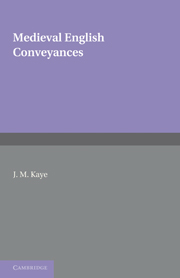Book contents
- Frontmatter
- Contents
- Preface
- Abbreviations and references
- List of year book cases
- Introduction
- 1 Common clauses in deeds
- 2 Grants in fee: general
- 3 Grants in fee: special cases
- 4 Grants in marriage, limited fee and fee tail
- 5 Grants in alms
- 6 Women's realty
- 7 Confirmations
- 8 Grants for life and for lives
- 9 Grants for terms of years
- 10 Rents
- 11 Exchanges
- 12 Surrenders and releases
- 13 Villeins and their lands
- Glossary of legal terms
- Select Bibliography
- Index
Introduction
Published online by Cambridge University Press: 29 January 2010
- Frontmatter
- Contents
- Preface
- Abbreviations and references
- List of year book cases
- Introduction
- 1 Common clauses in deeds
- 2 Grants in fee: general
- 3 Grants in fee: special cases
- 4 Grants in marriage, limited fee and fee tail
- 5 Grants in alms
- 6 Women's realty
- 7 Confirmations
- 8 Grants for life and for lives
- 9 Grants for terms of years
- 10 Rents
- 11 Exchanges
- 12 Surrenders and releases
- 13 Villeins and their lands
- Glossary of legal terms
- Select Bibliography
- Index
Summary
In England, the practice of embodying land transactions, made by persons other than kings, in written documents got off to a very slow start, unless one assumes heavy losses of material. For the whole Anglo-Saxon period fewer than three hundred non-royal charters survive, most of these made by bishops and other ecclesiastics. From the period between the Conquest and the later years of Henry I the number of surviving documents is likewise small, although there were a great many transfers of land in those years. The replacement by William I of most Anglo-Saxon tenants in chief by Frenchmen, for instance, seems to have been undertaken without documentation of any kind: the only known charter, purporting to be a grant by William to an incoming tenant in chief, has long been known to be a forgery. It may be that some writs were issued, ordering the putting into seisin of the new lords, but none has survived. The granting of land to hundreds of knights, by lay and ecclesiastical lords, which took place in the early Anglo-Norman period, is witnessed by only a few charters, not one of which was made by a lay lord. The transfer of lands by monarchs and magnates to the church is more fully documented. More than 180 religious houses (not counting hospitals) were founded between the Conquest and 1135, and grants to some of these by their founders and by other persons, together with grants to some of the sixty or so religious houses of pre-Conquest foundation, recorded in cartularies or in collections of original deeds, are the main source of conveyancing instruments for this period.
- Type
- Chapter
- Information
- Medieval English Conveyances , pp. 1 - 27Publisher: Cambridge University PressPrint publication year: 2009
- 1
- Cited by

